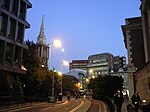St Augustine Papey
12th-century church buildings in England1547 disestablishments in EnglandChurches in the City of LondonFormer buildings and structures in the City of LondonLondon church stubs

St Augustine Papey was a mediaeval church in the City of London situated just south of London Wall opposite the north end of St. Mary Axe Street. First mentioned as "Sci augustini pappey", it originally belonged to the Priory of Holy Trinity. By 1430, the emoluments had become so small that it was united with All Hallows-on-the-Wall and in 1442 was appropriated as an almshouse for elderly clergy. At the time of the Dissolution of the Monasteries it was demolished and the site built over. The churchyard was acquired by St Martin Outwich in 1539, and survives to this day on Camomile Street
Excerpt from the Wikipedia article St Augustine Papey (License: CC BY-SA 3.0, Authors, Images).St Augustine Papey
Bury Court, City of London
Geographical coordinates (GPS) Address Website Nearby Places Show on map
Geographical coordinates (GPS)
| Latitude | Longitude |
|---|---|
| N 51.5148 ° | E -0.0796 ° |
Address
Site of the Fall - study of the renaissance garden: Action 180: At 9:15 am Sunday 28 May 1967
Bury Court
EC3A 5AX City of London
England, United Kingdom
Open on Google Maps






